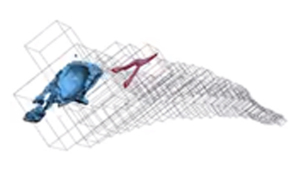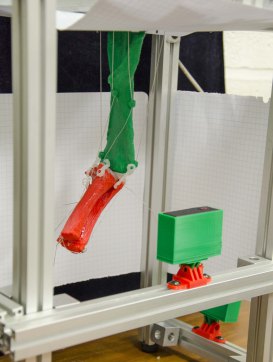With their discovery of Dreadnoughtus schrani in 2014, a team of Drexel University researchers unearthed not only the most complete skeleton of a new species of supermassive dinosaur, but also a trove of research opportunities. One of the first of these endeavors to take shape at Drexel is an effort to better understand how the dinosaur might have moved. Understanding how dinosaurs moved is a fascinating question under any circumstances—but especially so for Dreadnoughtus because, as one of the largest-known animals to ever walk the Earth, its limbs must have tested the limits of what’s possible for locomotion on the surface of this planet.
Here’s a look at the process Drexel researchers are using to bring a 3-D printed, scale model of a Dreadnoughtus limb to life.
1. Find a massive, amazingly complete dinosaur skeleton.

Yes, this is a difficult first step, but Dr. Kenneth Lacovara, a professor at Rowan University and paleontologist from the Academy of Natural Sciences has already done the heavy lifting here. Lacovara revealed his discovery of Dreadnoughtus schrani in 2014 while he was a professor at Drexel. It is the most complete skeleton among the largest dinosaurs yet discovered.
2. 3-D scan the bones.

It took Lacovara’s lab and a team of roughly 100 volunteers about 600 hours to digitally capture the physical form of all 145 of the Dreadnoughtus bones using a 3-D laser scanner. The “virtual mount” of the entire skeleton is available for download. This process is an important part of modern paleontology as it allows researchers from around the world to study the bones up-close, even if they’re far away.
3. Build a digital model.

Once the bones were scanned, Kristyn Voegele, a doctoral candidate in the College of Arts and Sciences, started to put together a biomechanical computer model to begin the process of understanding how the dinosaur might have moved.
 Some of the scans require a bit of digital editing to “repair” deformations. Fortunately, Emma Fowler, an undergraduate in Pennoni Honors College studying animation and paleontology, has the ability to undo 77 million years of natural geologic deformation in just a few hours by using an image-editing program called Maya.
Some of the scans require a bit of digital editing to “repair” deformations. Fortunately, Emma Fowler, an undergraduate in Pennoni Honors College studying animation and paleontology, has the ability to undo 77 million years of natural geologic deformation in just a few hours by using an image-editing program called Maya.
Then, using a dynamic simulation program called MSC Adams, Voegele attached virtual muscles and ligaments to the bones.
“Our reconstruction of the joint is based partly on the morphology of the bone—the shape and well-preserved muscle-attachment scars give us a good idea about where tendons and muscles might have been attached,” Voegele said. “We also look at the joints of reference species like chickens and crocodiles, which are the closest living relatives and are predicted to share many physiological characteristics with dinosaurs.”
One of the big questions that a dynamic forelimb model could help answer is about the shape of dinosaur cartilage. Unlike the dinosaur’s bones, its cartilage, tendons and muscles did not stand the test of time—but the digital model helps Voegele reassemble the biological puzzle, using the shape of the bones, clues from modern reference species and the motion of the joint model to guide her.
Each digital muscle, ligament and bone placement shapes the movement of the limb in the model. But to get a better look at how a physical model might be affected by the pull of gravity and the grind of moving bones, the team reached out to James Tangorra, PhD, an associate professor in the College of Engineering and head of the Laboratory for Biological Systems Analysis.
4. 3-D print the limb bones…
In addition to the digital models, the scans of the bones can also be used to print 3-D replicas. With a MakerBot 3-D printer it takes David McDevitt, an undergraduate researcher in Tangorra’s lab, about 12 hours to create a 1/10-scale version of one of Dreadnoughtus’s arm bones—it’s about six inches long.
The three bones that Voegele is focusing on right now form part of what would have been Dreadnoughtus’s left arm (the elbow of the 9-foot appendage).
“We started with the forelimb because the fossilized bones were the best preserved and have some of the most distinct features that indicate muscle and tendon attachment,” Voegele said.
The details of the bones are recreated to-scale with polylactic acid, which, when cooled, roughly mimics their density (it’s also reusable in the event of a printer error).
5. …and the joints.

Voegele’s digital models indicate a strong likelihood that Dreadnoughtus had cartilage with features very similar to the reference species based on the resulting smoother and efficient motion of the limb. The forelimb model in McDevitt’s rig is a good way to test the hypothesis under more lifelike rigors.
“We can use the modeling program to come up with a few designs that might make sense in context of the rest of the joint,” Voegele said.
McDevitt also prints Voegele’s cartilage designs using the MakerBot, this time printing the shapes in a negative space as a mold that he uses to form the cartilage in silicone rubber, which produces a more flexible pad.
In order to attach the simulated ligaments, McDevitt added six tiny nubs to the bone schematic before printing. Positioned where Voegele’s digital model suggests the dinosaur’s ligaments were likely attached, these nubs act as hooks for the limb model’s three rubber band-like ligaments.
6. Some assembly required.

To add the muscle power that will direct the movement of the limb, McDevitt created a biomechanical rig that looks like a sophisticated, lab bench-sized set of monkey bars. But for this project, the object dangling from them is a miniature dinosaur limb.
The rig is equipped with three banks of motors that simulate the movement of three opposing muscle groups by alternately spooling and unspooling Teflon-coated steel cables that are threaded over frictionless rollers and attached to the bones.
With Voegele’s schematic on hand, McDevitt connects the cables to the bones, roughly where the muscles would have been attached. Then he inserts the cartilage and links the tendon bands to hold the joint together.
The final result is a dinosaur forelimb suspended in the middle of the rig amidst three walls of graphing paper, which are used as a visual reference.
7. Time to flex.

With a few keystrokes, McDevitt can set the limb into motion. It’s a basic movement right now, one that could be equated to bending and straightening your arm.
In just a few minutes the limb flexes dozens of times. Cameras record the movement from three different angles. This footage will be compared to both the digital model and recordings made after adjusting various aspects of the bone, cartilage and muscles.
 “This is basically a plug-and-play model,” McDevitt said. “We can print out any of the bone scans or cartilage designs that Kristyn sends over. And it’s easy enough to attach the simulated muscles and ligaments at different positions on the bones.”
“This is basically a plug-and-play model,” McDevitt said. “We can print out any of the bone scans or cartilage designs that Kristyn sends over. And it’s easy enough to attach the simulated muscles and ligaments at different positions on the bones.”
The value of having a physical model, according to Voegele, is that its movement is naturally governed by gravity and the shape of the bones—two elements that would take quite a while to properly control for in a computer simulation.
“These two forces were the big factors at play when dinosaurs moved. We suspect that energy efficiency and conservation had a lot to do with their behavior and movement, so being able to study movement from a biomechanical standpoint gives us a great perspective on how these creatures might have moved.”